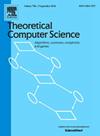近视机器人在无限三角形网格上的时间优化集结
IF 0.9
4区 计算机科学
Q3 COMPUTER SCIENCE, THEORY & METHODS
引用次数: 0
摘要
这项工作涉及的问题是,在一个无限三角形网格上的一个点(事先不知道)上,聚集 n 个被称为机器人的遗忘移动实体。机器人被认为是近视眼,即机器人的可见度有限。早期的收集工作大多将机器人置于平面、圆形或矩形网格上,既考虑了完全可见性,也考虑了有限可见性。在三角形网格中,据我们所知有两项研究。第一项是 Cicerone 等人关于任意模式形成的研究,其中考虑了完全可见性。另一项研究由 Shibata 等人完成,该研究考虑了在完全同步调度下,七个具有 2 跳可见度的机器人在无碰撞环境中组成一个六边形,其中一个机器人位于六边形的中心。在这项研究中,我们首先证明,如果机器人在任何轴上都不一致,那么即使在完全同步调度下,具有 1 跳可见度的机器人也不可能在三角形网格上聚集。因此,本研究考虑的是单轴一致(即机器人在一个方向及其方位上达成一致)。我们还证明,当 n 个机器人聚集在一个无限三角形网格上时,时间下限为 Ω(n) 个历时。随后,我们提出了一种算法,在半同步调度程序下,由 n 个机器人组成的具有 1 跳可见度的机器人群可以在 O(n) 个历时内聚集。因此,这里介绍的算法在时间上是最优的。本文章由计算机程序翻译,如有差异,请以英文原文为准。
Time optimal gathering of myopic robots on an infinite triangular grid
This work deals with the problem of gathering n oblivious mobile entities, called robots, at a point (not known beforehand) placed on an infinite triangular grid. The robots are considered to be myopic, i.e., robots have limited visibility. Earlier works of gathering mostly considered the robots either on a plane or on a circle or on a rectangular grid under both full and limited visibility. In the triangular grid, there are two works to the best of our knowledge. The first one is by Cicerone et al. on arbitrary pattern formation where full visibility is considered. The other one by Shibata et al. which considers seven robots with 2-hop visibility that form a hexagon with one robot in the center of the hexagon in a collision-less environment under a fully synchronous scheduler.
In this work, we first show that gathering on a triangular grid with 1-hop vision of robots is not possible even under a fully synchronous scheduler if the robots do not agree on any axis. So one axis agreement has been considered in this work (i.e., the robots agree on a direction and its orientation). We have also shown that the lower bound for time is epochs when n number of robots are gathering on an infinite triangular grid. An algorithm is then presented where a swarm of n number of robots with 1-hop visibility can gather within epochs under a semi-synchronous scheduler. So the algorithm presented here is time optimal.
求助全文
通过发布文献求助,成功后即可免费获取论文全文。
去求助
来源期刊

Theoretical Computer Science
工程技术-计算机:理论方法
CiteScore
2.60
自引率
18.20%
发文量
471
审稿时长
12.6 months
期刊介绍:
Theoretical Computer Science is mathematical and abstract in spirit, but it derives its motivation from practical and everyday computation. Its aim is to understand the nature of computation and, as a consequence of this understanding, provide more efficient methodologies. All papers introducing or studying mathematical, logic and formal concepts and methods are welcome, provided that their motivation is clearly drawn from the field of computing.
 求助内容:
求助内容: 应助结果提醒方式:
应助结果提醒方式:


